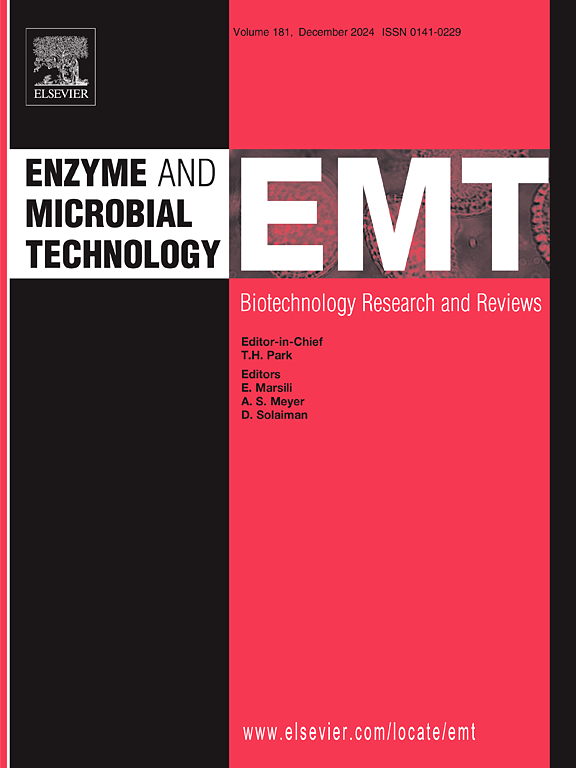Biochemical characterization and structure prediction of the Cerrado soil CRB2(1) metagenomic dioxygenase
IF 3.4
3区 生物学
Q2 BIOTECHNOLOGY & APPLIED MICROBIOLOGY
引用次数: 0
Abstract
Dioxygenases are enzymes involved in the conversion of polyconic aromatic hydroxycarbons (PAHs), attracting significant biotechnological interest for the conversion of recalcitrant organic compounds. Furthermore, few studies show that dioxygenases can take on the function of resistance genes in clones. This enzymatic versatility opens up new opportunities for elucidating the mechanisms of microbial resistance, as well as its biotechnological application. In this work, a Cerrado soil dioxygenase named CRB2(1) was biochemically characterized. The enzyme was shown to have optimal activity at pH 7; a temperature of 30 °C; and using iron ions as a cofactor for substrate cleavage. The kinetic catalytic parameters of CRB2(1) were Vmax = 0.02281 µM/min and KM = 97.6. Its predicted three-dimensional structure obtained using the Modeller software v9.22 based on the crystal structure of gentisate 1,2-dioxygenase from Silicibacter pomeroyi (GDOsp) (PDB ID 3BU7, resolution 2.80 Å, residues 17–374) revealed substrate binding to the cupin domain, where the active site is located. The analyzed substrates interact directly with the iron ion, coordinated by three histidine residues. Changing the iron ion charge modifies the binding between the active site and the substrates. Currently, there is a demand for enzymes that have biotechnological activities of interest. Metagenomics allows analyzing the biotechnological potential of several organisms at the same time, based on sequence and functional activity analyses.
Cerrado土壤CRB2(1)元基因组二氧酶的生化特征和结构预测。
二氧酶是一种参与多环芳烃(PAHs)转化的酶,在转化难降解有机化合物方面引起了生物技术的极大兴趣。此外,很少有研究表明二氧酶可以在克隆中承担抗性基因的功能。这种酶的多功能性为阐明微生物抗性机理及其生物技术应用提供了新的机遇。在这项工作中,对一种名为 CRB2(1) 的 Cerrado 土壤二氧酶进行了生物化学鉴定。研究表明,该酶在 pH 值为 7、温度为 30 °C、以铁离子作为辅助因子裂解底物时具有最佳活性。CRB2(1) 的动力学催化参数为 Vmax = 0.02281 µM/min 和 KM = 97.6。根据波美拉尼亚硅杆菌(Silicibacter pomeroyi)的龙胆二酸 1,2-二氧合酶(GDOsp)晶体结构(PDB ID 3BU7,分辨率 2.80 Å,残基 17-374),使用 Modeller 软件 v9.22 对其三维结构进行了预测,结果显示底物与活性位点所在的杯状结构域结合。分析的底物直接与由三个组氨酸残基配位的铁离子相互作用。改变铁离子的电荷会改变活性位点与底物之间的结合。目前,人们需要具有生物技术活性的酶。元基因组学可以根据序列和功能活性分析,同时分析几种生物的生物技术潜力。
本文章由计算机程序翻译,如有差异,请以英文原文为准。
求助全文
约1分钟内获得全文
求助全文
来源期刊

Enzyme and Microbial Technology
生物-生物工程与应用微生物
CiteScore
7.60
自引率
5.90%
发文量
142
审稿时长
38 days
期刊介绍:
Enzyme and Microbial Technology is an international, peer-reviewed journal publishing original research and reviews, of biotechnological significance and novelty, on basic and applied aspects of the science and technology of processes involving the use of enzymes, micro-organisms, animal cells and plant cells.
We especially encourage submissions on:
Biocatalysis and the use of Directed Evolution in Synthetic Biology and Biotechnology
Biotechnological Production of New Bioactive Molecules, Biomaterials, Biopharmaceuticals, and Biofuels
New Imaging Techniques and Biosensors, especially as applicable to Healthcare and Systems Biology
New Biotechnological Approaches in Genomics, Proteomics and Metabolomics
Metabolic Engineering, Biomolecular Engineering and Nanobiotechnology
Manuscripts which report isolation, purification, immobilization or utilization of organisms or enzymes which are already well-described in the literature are not suitable for publication in EMT, unless their primary purpose is to report significant new findings or approaches which are of broad biotechnological importance. Similarly, manuscripts which report optimization studies on well-established processes are inappropriate. EMT does not accept papers dealing with mathematical modeling unless they report significant, new experimental data.
 求助内容:
求助内容: 应助结果提醒方式:
应助结果提醒方式:


